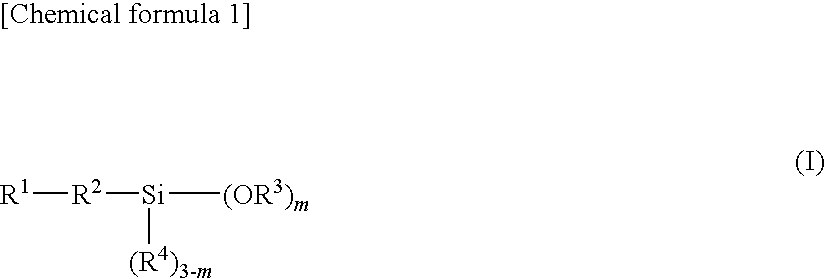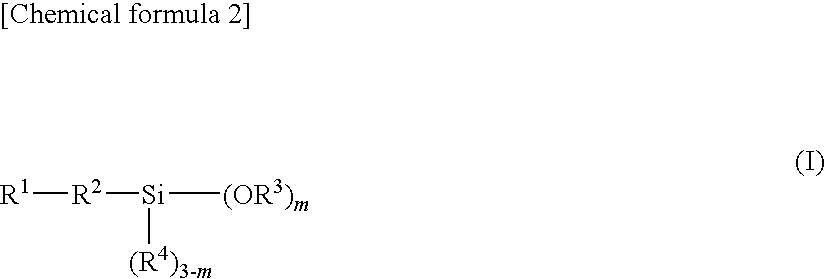Epoxy resin molding material for sealing and electronic component device
a technology of epoxy resin and sealing material, applied in the direction of transportation and packaging, synthetic resin layered products, adhesive types, etc., can solve the problems of package cracking, reduced package reliability, and generated exfoliation in the bonding interfa
- Summary
- Abstract
- Description
- Claims
- Application Information
AI Technical Summary
Benefits of technology
Problems solved by technology
Method used
Image
Examples
synthesis example 1
Synthesis of Alkoxysilane Polymer 1
[0156]Into a 500-mL four-necked flask equipped with a stirrer, a thermometer and a reflux condenser tube were charged 118.2 g of γ-glycycloxypropyltrimethoxysilane, 11.8 g of methanol, 6.3 g of water, and 56 g of an ion exchange resin (trade name: UMBERLIST (transliteration) 15DRY, manufactured by Organo Corporation), and then the components were stirred at room temperature for 2 hours. A filter paper was used to filtrate the resultant solution under normal pressure to remove the ion exchange resin, and then the filtrate was heated to 50° C. under a reduced pressure (13 hPa) to remove the low boiling point components, thereby yielding an alkoxysilane polymer 1 (transparent and colorless liquid, yield=87%, Mw=530, Mw / Mn=1.68, epoxy equivalent=282).
synthesis example 2
Synthesis of Alkoxysilane Polymer 2
[0157]Into a 500-mL four-necked flask equipped with a stirrer, a thermometer and a reflux condenser tube were charged 104.8 g of γ-glycycloxypropyltrimethoxysilane, 17 g of methanol, 13.5 g of water, and 20 g of an activated clay (trade name: NIKKANITE (transliteration) G-36, manufactured by Nippon Activated Clay Co., Ltd.), and then the components were stirred at refluxing temperature for 6 hours. The resultant solution was filtrated under a reduced pressure to remove the activated clay, and then the filtrate was heated to 50° C. under a reduced pressure (13 hPa) to remove the low boiling point components, thereby yielding an alkoxysilane polymer 2 (transparent and colorless liquid, yield=75%, Mw=700, Mw / Mn=2.1, epoxy equivalent=264).
synthesis example 3
Synthesis of Alkoxysilane Polymer 3
[0158]Into a 500-mL four-necked flask equipped with a stirrer, a thermometer and a reflux condenser tube were charged 104.8 g of γ-glycycloxypropyltrimethoxysilane, 17 g of methanol, 13.5 g of water, and 20 g of an activated clay (trade name: NIKKANITE (transliteration) G-168, manufactured by Nippon Activated Clay Co., Ltd.), and then the components were stirred at refluxing temperature for 6 hours. The resultant solution was filtrated under a reduced pressure to remove the activated clay, and then the filtrate was heated to 50° C. under a reduced pressure (13 hPa) to remove the low boiling point components, thereby yielding an alkoxysilane polymer 3 (transparent and colorless liquid, yield=70%, Mw=1100, Mw / Mn=2.2, epoxy equivalent=262).
PUM
| Property | Measurement | Unit |
|---|---|---|
| Percent by mass | aaaaa | aaaaa |
| Percent by mass | aaaaa | aaaaa |
| Molecular weight | aaaaa | aaaaa |
Abstract
Description
Claims
Application Information
 Login to View More
Login to View More - R&D
- Intellectual Property
- Life Sciences
- Materials
- Tech Scout
- Unparalleled Data Quality
- Higher Quality Content
- 60% Fewer Hallucinations
Browse by: Latest US Patents, China's latest patents, Technical Efficacy Thesaurus, Application Domain, Technology Topic, Popular Technical Reports.
© 2025 PatSnap. All rights reserved.Legal|Privacy policy|Modern Slavery Act Transparency Statement|Sitemap|About US| Contact US: help@patsnap.com



